Low Yield, High Risk: How Canada’s SMR Strategy Increases the Global Diversion Threat
Executive Summary
Canada has positioned itself as a global leader in small modular reactor (SMR) development, with the April 2025 approval of Ontario Power Generation’s BWRX-300 reactor at the Darlington site framed as a milestone in clean energy innovation. What has received less attention is the security and proliferation risk profile of the very reactors now being licensed.
The BWRX-300, like most SMRs in commercial development, relies on low-enriched uranium (LEU). While LEU is below the threshold of weapons-grade material, it remains direct-use material under IAEA safeguards definitions. It can be further enriched or repurposed by state or non-state actors with technical capacity. The diversion risk is not theoretical. It is a recognized vulnerability embedded in the fuel cycle.
The Canadian Nuclear Safety Commission (CNSC), which approved the BWRX-300 for construction, has not released a public risk assessment or diversion analysis specific to the SMR class. There is no disclosed material accounting plan. No IAEA-reviewed safeguards adaptation. No transparency around enriched fuel transport routes, reprocessing protocols, or site-specific storage security.
Instead, the regulator has adopted a phased licensing model that delegates critical oversight steps to internal staff and accepts vendor-submitted fuel security claims under commercial confidentiality.
This posture, replicated across Canada’s SMR file, effectively licenses a new fissile material flow architecture with no modern safeguards framework in place. It establishes regulatory precedent for the export of enrichment-reliant technologies without first proving the integrity of their fuel chain. It expands Canada’s exposure under the Non-Proliferation Treaty, and undermines the credibility of global nuclear restraint at a time of rising geopolitical instability.
The SMRs may be small. The oversight footprint is smaller. But the risk — technical, diplomatic, and reputational — is not.
This briefing outlines how Canada’s current SMR strategy increases the probability of material diversion, safeguards erosion, and policy failure, and why the Darlington BWRX-300 license may be remembered less as a clean energy breakthrough and more as the moment the backdoor opened.
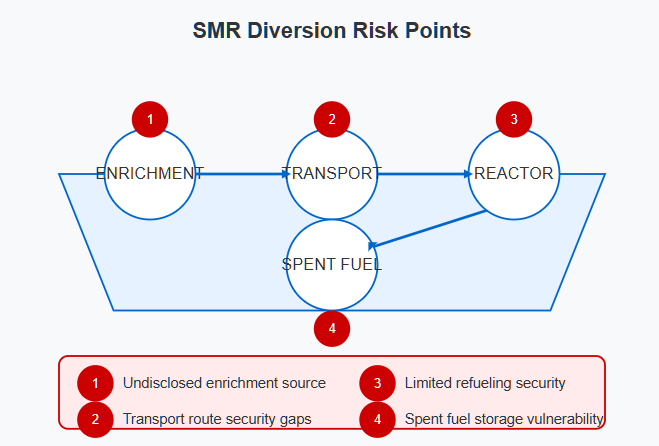
I. The SMR Approval Loophole
Small Modular Reactors (SMRs) are being licensed in Canada under regulatory assumptions that no longer match their operational or geopolitical reality.
The CNSC’s phased licensing model — as applied to Ontario Power Generation’s BWRX-300 — is derived from protocols developed for large, conventional, grid-anchored power reactors. These reactors typically use low-enriched uranium (LEU) with extensive on-site security infrastructure, fixed geography, and decades of publicly vetted precedent.
The BWRX-300 replicates none of those conditions.
Instead, it introduces new fissile transport patterns, new handling vulnerabilities, and new opacity in the licensing process — while still benefiting from regulatory inertia that treats it as business as usual.
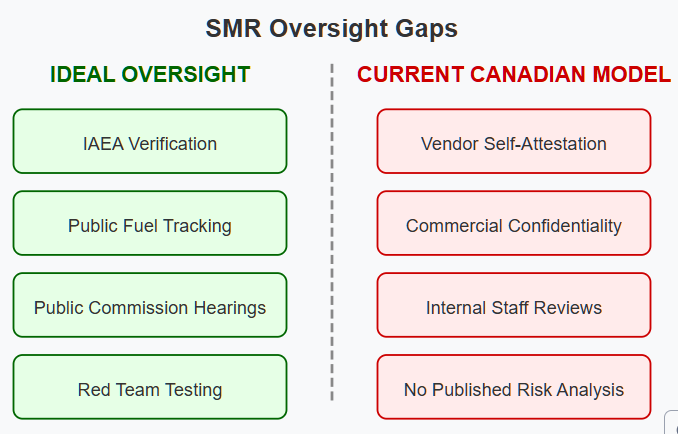
Key Factors Creating the Loophole:
1. LEU Under False Security
The BWRX-300 will operate on low-enriched uranium fuel, likely between 3–5% U-235. This is not weapons-grade, but it is weapons-adjacent. Under IAEA definitions, LEU is “direct-use” material: it requires no conversion to be used in a nuclear explosive device if enriched further. And once manufactured into fuel assemblies, it becomes diversion-sensitive cargo, especially during transport or refueling operations.
Despite this, CNSC documentation treats LEU as if it carries minimal risk — with no published transport threat models and no evidence of modern diversion simulations. The regulator’s confidence is based on historical precedent, not technical analysis.
2. First-of-a-Kind Reactors, Last-of-the-Old Rules
The BWRX-300 does not yet exist in operational form. No full-cycle test has been conducted under Canadian safeguards oversight. Yet the licensing was executed using a phased model, allowing fuel and security questions to be deferred to later licensing stages, where internal staff — not the Commission tribunal — will review and approve.
In other words: a new class of nuclear facility was approved under assumptions written for reactors it does not resemble, using a regulatory model that removes the public and parliamentary interface at every critical step.
3. No Divergence Doctrine
The CNSC has not issued a diversion risk framework specific to SMRs. There is no formal doctrine, public or internal, on:
- fuel shipment interdiction scenarios
- insider threat modeling at SMR-specific facilities
- foreign export vulnerabilities under bilateral agreements
The absence of a doctrine creates a regulatory vacuum, where risk is not denied — it is unacknowledged.
Strategic Consequences
- Canada has licensed a fissile material architecture with no doctrinal guardrails.
- The licensing of the BWRX-300 sets a precedent: future SMRs can point to this file as evidence that diversion risks are negligible — regardless of evidence.
- If another jurisdiction replicates this process with fewer safeguards and a worse security environment, Canada will own part of the template.
II. Safeguards by Vendor Assertion
Canada’s current approach to SMR security — including diversion and material control — is built not on field validation, but on vendor documentation and self-declared safeguards claims.
In the case of the BWRX-300, GE Hitachi has consistently promoted the reactor as “proliferation-resistant” based on several theoretical design features: passive safety systems, low-enriched uranium (LEU) fuel, and the absence of on-site fuel reprocessing. These characteristics are presented in promotional materials and regulatory filings as inherently risk-reducing.
They have not been independently verified.
CNSC’s Safeguards Model: Trust, Then License
The Canadian Nuclear Safety Commission (CNSC) has adopted a proponent-submission model for safeguards, in which reactor developers provide:
- Proprietary fuel cycle plans
- Transport logistics
- Material accounting methods
- Containment and surveillance frameworks
These submissions are largely exempt from public scrutiny, redacted in hearings, and reviewed solely by CNSC staff. No third-party audit process exists. The International Atomic Energy Agency (IAEA) has not publicly reviewed or validated Canada’s approach to SMR-specific safeguards adaptation.
In effect, security claims are accepted at face value, unless proven inadequate at a later stage — usually post-construction, pre-commissioning. At that point, the political and financial cost of delay becomes a deterrent to corrective action.
What the Vendor Says — and What No One Checks
GE Hitachi has made the following claims about the BWRX-300:
- It “cannot be used to produce weapons-grade material.”
- It uses fuel types that are “well understood and managed under existing safeguards.”
- It offers a “low proliferation profile” due to simplified design.
These statements are marketing rhetoric, not operational fact. There is no working BWRX-300. There is no deployed security architecture. There are no live data points on material tracking, diversion vulnerability, or transport route interdiction.
The CNSC has cited these assertions in licensing materials without qualifying them as unverified, untested, or provisional.
Institutional Dependence on Vendor Framing
This reliance on vendor framing is not a flaw in CNSC process — it is the process. The phased licensing structure delays hard regulatory judgment until after construction approval, by which point the safeguards debate becomes tactical, not structural.
Canada has now licensed a reactor class based on documents submitted by its developers, without applying safeguards rigor appropriate to first-of-kind technologies.
International Risk Transfer
- Other states will follow this model. Vendor assertion, regulator deference, minimal third-party challenge.
- Canada is establishing a playbook: market-friendly licensing that permits material movement without preemptive non-proliferation review.
- In any future incident of diversion, the lack of hard requirements or technical scrutiny will become part of Canada’s diplomatic exposure.
In nuclear governance, safeguards exist to catch what design claims miss. When those safeguards are reduced to paperwork and trust, the distinction between compliance and credulity disappears.
At present, Canada’s SMR oversight process operates on the assumption that vendors will not lie, fuel will not leak, and diversion will not occur. This is not security.
This is permission.
III. Global Implications for Canada’s Non-Proliferation Commitments
Canada has historically positioned itself as a responsible nuclear state, anchored by its adherence to the Non-Proliferation Treaty (NPT), its active participation in the International Atomic Energy Agency (IAEA), and its role in the Zangger Committee and Nuclear Suppliers Group (NSG). The credibility of this position relies on one foundational assumption: that Canada does not enable the spread of fissile materials or technologies that could be repurposed for weapons use.
That assumption is now in question.
The licensing of the BWRX-300 and other small modular reactors (SMRs) under Canada’s current regulatory model introduces systemic non-alignment with international safeguards expectations — especially in areas of:
- Fuel cycle transparency
- Independent verification
- Export protocol enforcement
- Enrichment and reprocessing disclosure
While these gaps have not yet resulted in a technical breach, they represent a growing divergence between Canada’s non-proliferation rhetoric and its licensing practice.
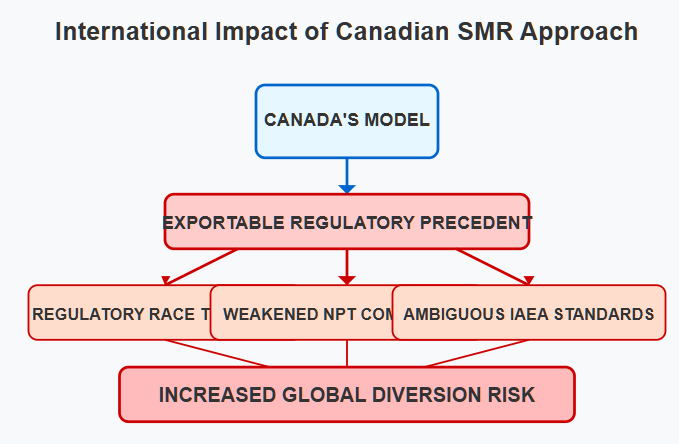
IAEA Alignment Is Theoretical, Not Operational
The IAEA has not issued definitive safeguards guidance for SMRs, in part because the technologies remain non-deployed. This vacuum gives national regulators discretion, but also creates a test case environment: what Canada approves first, others will cite later.
By proceeding without a published, enforceable SMR safeguards framework, Canada has established a permissive precedent that weaker states may exploit. A reactor type licensed in Ontario may soon be cited as justification for similar deployments — without matching security infrastructure — in jurisdictions with higher diversion risk and lower regulatory capacity.
If that happens, Canada will be listed as the precedent-setting authority, even if the replication is imperfect. This is how reputational fallout metastasizes.
Export Exposure and Technology Leakage
GE Hitachi, the vendor behind the BWRX-300, has stated its intent to market the reactor globally, including in:
- Poland
- Ukraine
- Estonia
- The United Kingdom
- Sub-Saharan Africa (under exploratory partnership models)
Some versions of the BWRX-300 may be partially fabricated in Canada, especially during early deployment phases. If that occurs, the CNSC’s approval becomes an enabling instrument in international nuclear trade, with diplomatic liability attached to every exported module.
Canada may not be the operator. But Canada becomes, by proxy, a certifier of safety and non-diversion — without possessing the tools to enforce either beyond its borders.
Treaty Tension: The NPT and NSG Mandates
The NPT obligates Canada to ensure that peaceful nuclear energy is not diverted to nuclear weapons or other nuclear explosive devices. The NSG imposes additional guidelines on technology transfer and dual-use restrictions.
By licensing reactors with:
- Non-transparent fuel supply chains
- No dedicated reprocessing ban
- No formal enrichment source disclosure
…Canada risks soft violations of the spirit — if not the letter — of its international obligations.
These are not technicalities. They are thresholds. And Canada is now standing on the edge of them.
The Risk Is Not That SMRs Will Be Misused in Canada
The risk is that Canada’s regulatory model will be exported — and misused elsewhere. And when diversion occurs — through enrichment creep, unmonitored refueling, or disguised fuel reprocessing — Canada will be asked:
- Why it didn’t require more.
- Why it trusted design over doctrine.
- Why it assumed the future would behave.
This is how a policy becomes a liability. Not through one decision. But through repetition, silence, and international mimicry.
Canada’s SMR license approvals are being watched. They are being interpreted. And if they are not restructured, they will be repeated — by governments far less stable, with outcomes far more permanent.
IV. Security Through Ambiguity: Fuel Type, Transport, and Facility-Specific Risk
While Canada’s public-facing narrative around SMRs emphasizes safety, simplicity, and environmental benefit, its handling of nuclear material transport and on-site fuel security remains opaque, unmodeled, and unaccounted for in the public record.
The BWRX-300, like other light-water SMR designs, uses low-enriched uranium (LEU) fuel that requires periodic replacement. This is not a sealed-core or once-through fuel cycle. It is routine refueling at fixed facilities — introducing recurring transport windows and storage vulnerabilities over the life of the reactor.
The CNSC has not published a detailed diversion risk analysis associated with:
- Fuel transport from enrichment source to reactor site
- On-site fuel storage prior to loading
- Spent fuel management during shutdown or extended outages
These absences are not technical oversights. They are policy decisions.
Fuel Handling Is the Vulnerability
Contrary to the promotional framing of SMRs as “secure by design,” the fuel cycle for BWRX-300-style reactors involves multiple high-interest phases:
- Enrichment and fabrication (likely international)
- Cross-border transport via rail or truck
- On-site storage in above-ground bunkers or casks
- Spent fuel staging prior to long-term waste disposition
Each of these points represents an actionable threat node for diversion, interception, or sabotage. None of them are subject to public safeguards review.
CNSC documentation refers vaguely to “established transport protocols” and “proponent-led fuel logistics,” most of which are classified under commercial confidentiality. The public, and Parliament, are left to assume that invisible systems are functioning flawlessly.
No Public Risk Modelling
There is no published scenario planning for:
- Fuel shipment interdiction by state or non-state actors
- Insider threat at SMR facilities
- Storage breach during reactor downtime
- Reprocessing risk if spent fuel is diverted or transferred to a non-compliant facility
In fact, CNSC licensing language explicitly avoids such modeling — choosing instead to defer risk assessment to future compliance verifications. These occur after construction, and often under internal CNSC staff review, with no requirement for public hearing or tribunal oversight.
This creates a system where material risk is real but procedurally invisible.
The Regulatory Bet: No One Will Ask
The unspoken logic behind Canada’s SMR rollout is that the reactors are too small, too clean, and too Western to provoke meaningful scrutiny. That assumption holds — until the first fuel shipment goes missing, or a temporary on-site bunker is breached, or a sympathetic government replicates Canada’s process in a less stable environment.
At that point, fuel logistics will become the lead story. And the question will not only be whether Canada acted maliciously — but also whether it acted naïvely.
Intelligence Summary
| Risk Element | Oversight Status |
|---|---|
| Fuel enrichment source disclosure | ❌ Absent |
| Transport route security mapping | ❌ Not published |
| Spent fuel diversion scenario | ❌ Not modeled |
| Insider threat mitigation | ❌ Undeclared |
| Facility-specific sabotage planning | ❌ No public framework |
Until Canada brings SMR fuel cycle security into public oversight and international compliance, its model will remain not just a regulatory experiment — but a calculated ambiguity at the core of the non-proliferation regime.
And ambiguity is not safety. It is a delay mechanism. One that expires the moment anything goes wrong.
V. Recommendations & Intelligence Markers
The approval of the BWRX-300 reactor under Canada’s current SMR licensing regime represents a critical fissile material oversight gap. Unless specific safeguards, transparency protocols, and international verification mechanisms are immediately adopted, Canada will escalate from policy laggard to proliferation enabler.
This section outlines recommended actions to contain diplomatic fallout, shore up material security, and flag high-risk vectors within Canada’s emerging small reactor infrastructure.
Policy-Level Recommendations
1. Immediate Moratorium on SMR Construction Licensing
Until diversion, transport, and enrichment safeguards have been publicly reviewed and verified by third parties. Applies to:
- BWRX-300 at Darlington
- Any pending SMR license involving LEU or HEU transport or use
2. Publish an SMR-Specific Diversion Doctrine
- Include thresholds for material classification, inspection frequency, and real-time fuel tracking
- Require independent fuel cycle audits, not vendor attestations
3. Mandate IAEA Co-Review
All SMR design approvals, fuel movement, and facility-level safeguards must be reviewed in parallel by the IAEA under Article III of the NPT.
4. Disclose Fuel Origin, Enrichment Facility, and Transport Mode
Publicly document:
- Enrichment country and facility
- Transport carrier and route (or general corridor)
- Physical protection regime during movement
This is standard in most NPT-compliant jurisdictions with active nuclear export programs. Canada has not matched that bar.
5. Conduct a Red-Teaming Exercise Before Fuel Load
An inter-agency simulation of:
- Transport interdiction
- Insider sabotage during fuel staging
- Post-shutdown material breach Results should inform both CNSC protocol and public reporting requirements.
Intelligence Markers to Monitor
These are indicators of elevated diversion risk or regulatory collapse. Each warrants immediate attention from foreign affairs, public safety, and defense analysts.
1. Enriched Fuel Movement Without Public Disclosure
Flag any LEU or HEU shipments that:
- Occur without media notification
- Lack disclosed routing corridors
- Use third-party contractors without public registration
2. CNSC Licensing Without Tribunal-Level Oversight
Monitor any hold-point removals or construction milestones approved by CNSC staff alone, without public hearing or published record.
3. Export Negotiations with Non-NPT Signatories
Track commercial discussions between Canadian SMR vendors and:
- Middle East clients outside IAEA Additional Protocol coverage
- Non-aligned states with enrichment ambitions
- “Green energy partnerships” lacking nuclear treaty constraints
4. Fuel Substitution or Design Modifications Post-Approval
Any reactor that undergoes fuel cycle changes (e.g., shift to higher enrichment, alternative cladding, new transport method) post-licensing should trigger automatic safeguards reevaluation.
5. IAEA Silence
Prolonged non-engagement or absence of IAEA comment on Canadian SMR developments may signal:
- Lack of alignment
- Bypassed consultation
- Imminent reputational fallout
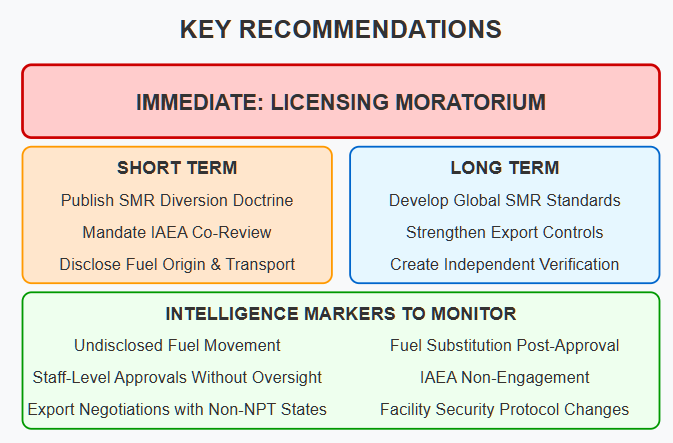
Summary
Canada’s current SMR posture assumes safety through design, and compliance through trust. Neither is adequate in a global nuclear ecosystem where diversion is a question of opportunity, not intent.
This is not about whether Canadian reactors will be misused domestically. It is about whether Canada has built — and exported — a procedural blueprint that allows others to do so.
The safeguards gaps are now mapped. The failure points are visible. All that remains is whether anyone acts before they are exploited.
Appendix A: BWRX-300 Fuel Profile vs. IAEA Risk Thresholds
The GE Hitachi BWRX-300 reactor, approved for construction at Darlington in April 2025, will utilize low-enriched uranium (LEU) fuel assemblies, enriched to a level just below 5% U-235. This falls under the IAEA classification of “direct-use material” — fuel that can be used in the production of nuclear weapons with minimal further enrichment or chemical separation.
This fuel type does not fall outside IAEA safeguards. It falls directly within them.
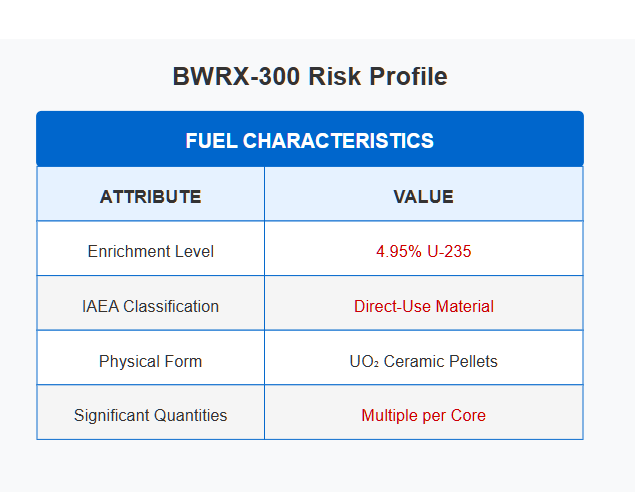
Key Risk Characteristics of BWRX-300 Fuel
| Attribute | Relevance |
|---|---|
| Enrichment Level | 4.95% U-235 (nominal) — within striking distance of weapons-grade (90%), but usable in a radiological device at far lower concentrations |
| Fuel Form | Standard ceramic UO₂ pellets, configured in light-water reactor assemblies — transportable, substitutable |
| Storage Profile | Above-ground interim storage, with likely dry cask staging — high-value target |
| Refueling Cycle | Not sealed-core; requires periodic access to fresh fuel and spent fuel handling — creates repeated vulnerability windows |
| Export Variant Compatibility | Modular design, easily containerized — facilitates off-site fabrication and cross-border transport |
IAEA Threshold Comparisons
- Under IAEA definitions, 25 kg of U-235 in LEU form constitutes a Significant Quantity (SQ) — the amount theoretically required for one nuclear explosive device.
- A single BWRX-300 core contains multiple SQs of U-235.
- Canada has no published doctrine for tracking or verifying SQ-relevant material flow in SMR-class reactors.
Strategic Concern
By approving reactors that:
- Contain multiple Significant Quantities of direct-use material
- Lack real-time tracking or independent monitoring infrastructure
- Operate under a “trust-based” fuel accounting regime
…Canada is now hosting and potentially exporting reactor systems with high proliferation utility and minimal safeguard friction.
This is not an accident. It is the result of design deference, regulator discretion, and IAEA procedural lag. And it remains unresolved.
Appendix B: Known Vendor Claims & Unverified Assertions
GE Hitachi’s BWRX-300 and the Strategic Liability of Marketing Language
Throughout the Darlington licensing process, GE Hitachi Nuclear Energy has made repeated claims about the security, safety, and proliferation-resistance of the BWRX-300 reactor. These claims have been cited in CNSC documentation, industry whitepapers, and political briefings without independent challenge or technical validation.
The following are the most commonly repeated assertions — none of which have been tested, peer-reviewed, or verified under operational conditions.
Vendor Claim: “Proliferation-resistant by design”
Status: ❌ Not verified
Comment: Based on the absence of on-site reprocessing and use of LEU. No independent modeling has been conducted to assess diversion risk during fuel shipment, storage, or post-use decay stages. No sealed-core design implemented.
Vendor Claim: “Simplified fuel cycle”
Status: ⚠️ Partially true
Comment: The reactor uses known light-water reactor fuel forms, but requires periodic refueling. Simplification reduces cost, not vulnerability. Multiple fuel handoff points increase exposure to diversion scenarios.
Vendor Claim: “Cannot be used to produce weapons-grade material”
Status: ❌ Technically false
Comment: While the reactor does not enrich fuel on site, the LEU it uses is classified as direct-use under IAEA safeguards. Any enrichment-capable state or actor with access to this fuel can increase its enrichment level. “Cannot” is inaccurate.
Vendor Claim: “Small scale reduces threat profile”
Status: ❌ Unsupported
Comment: Physical footprint is not a reliable proxy for strategic risk. Smaller facilities may have weaker physical protection regimes. Smaller reactors still contain multiple Significant Quantities (SQ) of U-235.
Additional Notes:
- No full-cycle BWRX-300 exists.
- No safeguards have been tested in an operational environment.
- No red-teaming, stress testing, or IAEA challenge reviews have been completed.
- CNSC licensing documents accept these vendor claims without qualification.
Conclusion
The current SMR licensing structure in Canada has adopted vendor marketing language as regulatory truth. These claims have not been contested or subjected to international scrutiny. In the absence of verification, they should not be considered risk mitigation — they should be treated as open vulnerabilities wearing confident language.
This is not a safeguards regime. It is the standard CNSC compliance façade.

